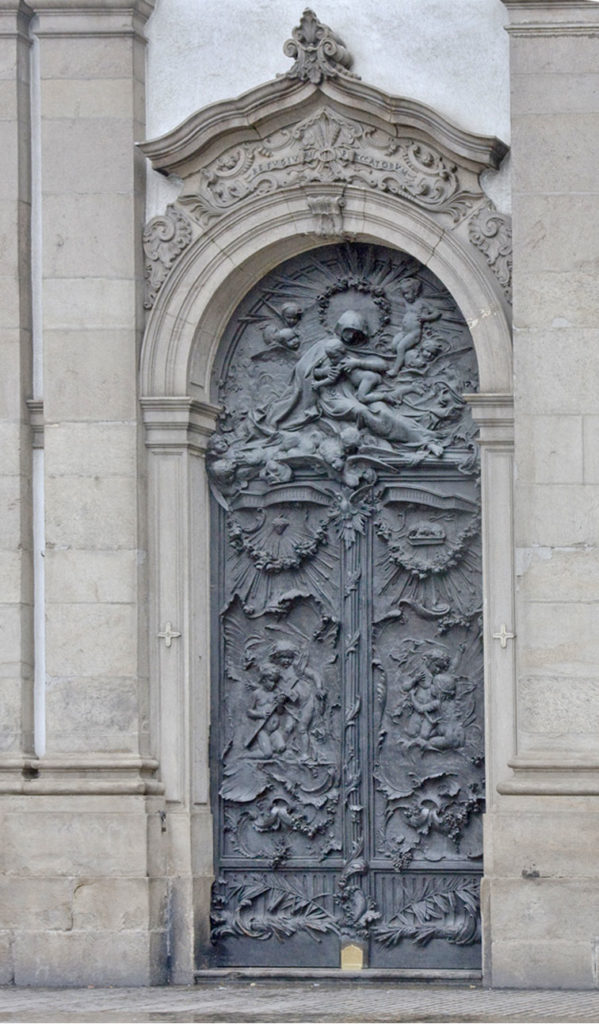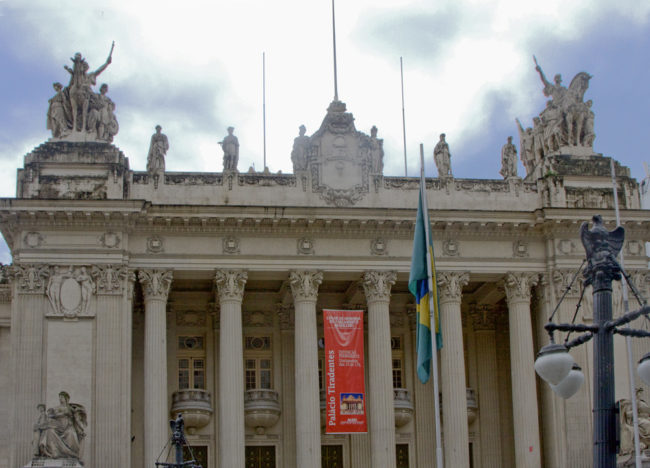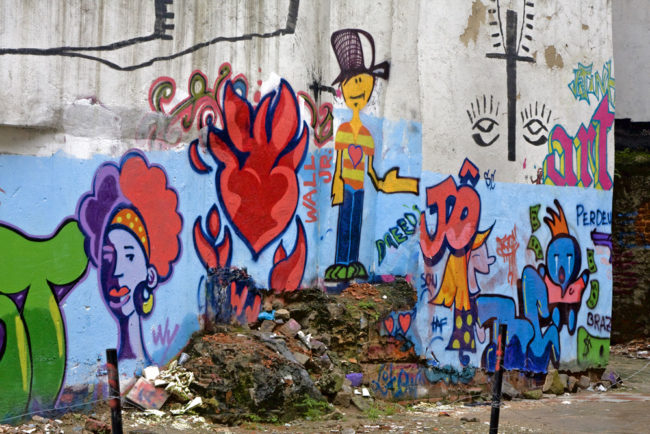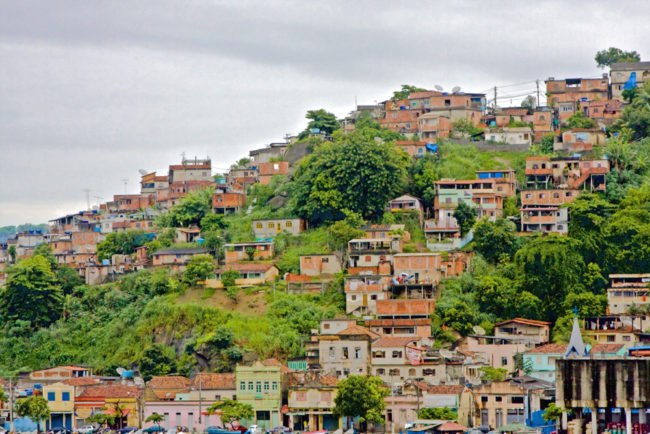Second day in Rio, part 2
We cruised through the streets of Niterói heading toward the bridge to Rio. The two ways to get from Niterói to Rio are the bridge and the ferry. It’s a short hop to the terminal in Niterói, and it lets off in Rio right downtown. But then there’s the bridge. We never saw any real traffic there, and when we were with Marcelo, that’s the route we took. But he also managed to tell us a few horror stories about the traffic there, enough to make us totally afraid of the unseen menace.
 We were itchy to get to Copacabana and pick up our Carnaval tickets. Jean had been dealing with several brokers at one location, going back and forth from elated to bummed out to broke to thrifty. We had finally landed on seats in Sector 7, which is for the locals. The tourist sector has reserved seats, but the only ones left were right on the ground. None of us thought that would be as good, and opted for taking our chances in Sector 7, which has no reserved seats. You just got there and plopped down, kind of like at a high school football game. The brokers assured us it would be a great Carnaval experience, and the tickets cost less than tourist sector. After having been once, I can see how it might be an interesting alternative to be at ground level–but not with the tourists–definitely with the locals.
We were itchy to get to Copacabana and pick up our Carnaval tickets. Jean had been dealing with several brokers at one location, going back and forth from elated to bummed out to broke to thrifty. We had finally landed on seats in Sector 7, which is for the locals. The tourist sector has reserved seats, but the only ones left were right on the ground. None of us thought that would be as good, and opted for taking our chances in Sector 7, which has no reserved seats. You just got there and plopped down, kind of like at a high school football game. The brokers assured us it would be a great Carnaval experience, and the tickets cost less than tourist sector. After having been once, I can see how it might be an interesting alternative to be at ground level–but not with the tourists–definitely with the locals.
Marcelo went some mysterious way through Rio to Copacabana, occasionally pointing something out and telling us what it was. We passed a bunch of fantastic governmental buildings from the colonial period and later. They were huge, ornate, and filled with broken windows and covered with graffiti. They were right at eye level a lot of the time as we zoomed through Rio on the expressway. It broke my heart to see the waste of beauty and the destruction of same. I asked Marcelo if any of these historic treasures were being renovated for re-use. He said that a few were. At least they weren’t tearing them down. Better to have them sit there and be reawakened at a later date by somebody with some vision than to be bulldozed just for the land. But I suspect there isn’t a bunch of money lying around Rio to participate in THAT KIND of foolishness.
We wound through downtown Rio, weaving our way to Copacabana. Everything was closed. And I mean EVERYTHING. The metal garage-type doors were down everywhere. Each was covered with graffiti, of course, and it presented a creepy post-apocalyptic scene. Jean asked Marcelo why everything was closed for Carnaval, when it seems like the merchants could make more money when more people were in town. Marcelo replied in a tone filled with respect, humor and bewilderment, “Because they would rather be having fun.” And that RIGHT THERE is the heart of the Brazilian existence. Marcelo’s respect is well felt.
After ten or fifteen U-turns in various places, we arrived at the ticket place. It was still raining, and the sidewalk came right up to the street in a giant puddle. Marcelo pulled right up onto the sidewalk enough to park over the puddle for us to get out. Wow! Like an automotive Sir Walter Raleigh, he was! We all tiptoed out of the car, me especially, since I had on vented Crocs with socks (standard) and knew that the water could still rush into my shoe.
We dashed into the place, which was very cool, with no walls, only glass partitions and large curved counter at the back of the room. There were mannequins dressed in various Carnaval costumes, and pictures of the different samba schools on the walls. A couple of videos of a never-ending Carnaval (probably from last year) were going nonstop, and a staff of several good looking Brazilians was helping the clientele.
We were all elated to find that our tickets were indeed there, legit, and without strings or asterisks attached. We trooped back outside, dodging rain and puddles and piled back into the car. I had left my camera in duffel position right on Marcelo’s floor. Like leaving it with a priest. At that point we had decided that we lucked into meeting the only guy we would want to usher us through life in Rio. Particularly since Daniel and Patricia weren’t due to arrive till 7 a.m. the next morning. Marcelo was going to take us to Carnaval that night, then pick us back up when we called (expected to be around 4 a.m.) I never for one minute thought anything different would happen, and it was one anxiety crossed off my list.
As we pulled off, Marcelo asked us where we wanted to go.
“Take us to see some old stuff,” I said. The others didn’t seem to care, and nodded in agreement.
“All right,” Marcelo said, and headed toward the old part of town. On the way, all of us asked him various questions, many inane. He would respond in his patented manner each time, and seemed to know more and more every time we asked him anything. I was giddy with busting down not only first-acquaintance barriers, but having another language coach to help me with my Jones to learn fluent Portuguese in three days.
We arrived at a square and parked with no difficulty. There was absolutely nobody downtown. We were right across from the Old Cathedral and next to the statue of Tiradentes, two vital pieces of not only Rio’s, but Brazil’s history as well.


 Somehow, this gorgeous Cathedral had escaped the insult of graffiti, as far as I could tell. Across the street was the Palacio Tiradentes, an old public building that was now serving as a museum. During our various excursions around Rio, Marcelo would point out several historic buildings that were now museums. I liked that.
Somehow, this gorgeous Cathedral had escaped the insult of graffiti, as far as I could tell. Across the street was the Palacio Tiradentes, an old public building that was now serving as a museum. During our various excursions around Rio, Marcelo would point out several historic buildings that were now museums. I liked that.

 In front of this fantastic building was a statue of Tiradentes, Brazil’s number one martyr. Marcelo gave us the lowdown. (Man! He knew a bunch about Brazilian history!) In a nutshell, during the late 1700s, Portugal was taking Brazil’s gold (a true motherlode) rapidly, and using the Brazilians to mine it. When they mined less than Portugal expected, they were taxed on the difference. Tiradentes saw the heinous inequity, and plotted to overthrow the whole rotten deal and establish freedom for the people. He was betrayed by a man he believed to be a friend and compatriot. Tiradentes was arrested, hanged, then quartered, his body parts marched throughout Rio and sections of Brazil to truly quash any type of rebellion they may have had in mind. I hate people that do stuff like that.
In front of this fantastic building was a statue of Tiradentes, Brazil’s number one martyr. Marcelo gave us the lowdown. (Man! He knew a bunch about Brazilian history!) In a nutshell, during the late 1700s, Portugal was taking Brazil’s gold (a true motherlode) rapidly, and using the Brazilians to mine it. When they mined less than Portugal expected, they were taxed on the difference. Tiradentes saw the heinous inequity, and plotted to overthrow the whole rotten deal and establish freedom for the people. He was betrayed by a man he believed to be a friend and compatriot. Tiradentes was arrested, hanged, then quartered, his body parts marched throughout Rio and sections of Brazil to truly quash any type of rebellion they may have had in mind. I hate people that do stuff like that.
Here’s Tiradentes in his stony glory. Notice the shackles on his wrists if you can.

Another cool statue at the Palacio was kind of Mrs. Robinson-esque, if you ask me. I don’t know who these characters are, but I’m sure they’ve got a mythical story of some kind to tell. Look how tiny, yet adult, the guy is! What gives?
 We wandered further across the square, to where the old port was located. Marcelo explained that in the early 1900s, Rio had expanded their land mass by filling in part of the bay with old garbage and dirt, and making new real estate! This was part of an archaeological excavation that revealed the original port and structure fronting it. Elsewhere in Rio, there are remants of an ancient aqueduct that serviced the city. These pictures are particularly cool, with the old port structure juxtaposed with the modern mirror-fronted building behind it. The next picture features a local and his possessions. Was he homeless? I didn’t know. Marcelo didn’t volunteer any information if he had it.
We wandered further across the square, to where the old port was located. Marcelo explained that in the early 1900s, Rio had expanded their land mass by filling in part of the bay with old garbage and dirt, and making new real estate! This was part of an archaeological excavation that revealed the original port and structure fronting it. Elsewhere in Rio, there are remants of an ancient aqueduct that serviced the city. These pictures are particularly cool, with the old port structure juxtaposed with the modern mirror-fronted building behind it. The next picture features a local and his possessions. Was he homeless? I didn’t know. Marcelo didn’t volunteer any information if he had it.


We walked further down a cool alleyway next to a place where a horrible tragedy took place, according to Marcelo, but gol-durn if I can remember it! Maybe he will refresh my memory for accurate reporting. A whole family was burned up there in the 1700s, I know. And the place opened onto this cool alleyway, where we met a group from England! English-speaking Englishters! We had a brief exchange with them, before they figured out we were probably morons, and split. Notice the woman “splitting” in the photo. Her rainwear looks like something the Queen would wear. Frumpy, yet elegant, yet functional. How do they do it?
 After wandering through the alley, we came upon this sculpture that I swore I had seen before. I knew it was by a famous artist! I made Jean, Pettus and Robo pose by it. Their expressions tell the tale: “He’s an idiot.”
After wandering through the alley, we came upon this sculpture that I swore I had seen before. I knew it was by a famous artist! I made Jean, Pettus and Robo pose by it. Their expressions tell the tale: “He’s an idiot.”
 Well, I’m NOT! When I finally saw all my pictures, I realized that I had seen this very sculpture, or its brother, outside in Salvador at the Museum of Modern Art. HA! I emailed Carol, who did the research necessary to find out that the artist is José Resende. The work is untitled.
Well, I’m NOT! When I finally saw all my pictures, I realized that I had seen this very sculpture, or its brother, outside in Salvador at the Museum of Modern Art. HA! I emailed Carol, who did the research necessary to find out that the artist is José Resende. The work is untitled.
 We exited the series of alleys onto a stellar view of the Igreja de Candelária, one of the most exquisite churches in Rio. The first thing I noticed was the graffiti on the minarets. HOW did somebody get up there? Why were they not struck by lightning while defacing this incredible structure?
We exited the series of alleys onto a stellar view of the Igreja de Candelária, one of the most exquisite churches in Rio. The first thing I noticed was the graffiti on the minarets. HOW did somebody get up there? Why were they not struck by lightning while defacing this incredible structure?


And here’s Robo taking a video of the church with me bitching about the graffiti in the background.
 That boy can make a face, can’t he? It’s amazing the way he can contort those Nordic good looks into such great expressions. He and Pettus are both incredibly photogenic, and look like they stepped off the pages of some calendar for “Ski Stockholm” or something. The last photo shoot I did, I was playing “obnoxious car salesman sitting in hot tub talking on cell phone.” Enhhh. It’s a living.
That boy can make a face, can’t he? It’s amazing the way he can contort those Nordic good looks into such great expressions. He and Pettus are both incredibly photogenic, and look like they stepped off the pages of some calendar for “Ski Stockholm” or something. The last photo shoot I did, I was playing “obnoxious car salesman sitting in hot tub talking on cell phone.” Enhhh. It’s a living.
We continued our trek through the historic district. We were right on “First Avenue,” and Marcelo will have to clarify for me, but basically, this was the first street in Rio, or was named so because the Old Cathedral was on it. Marcelo, meu irmão! Help us here!
There were gorgeous architectural details everywhere, too many to photograph. I will say that an attitude like that does not an accurate record make. I see that though I shot over 1300 photos on this trip, I missed that many more opportunities for that many different pictures. Sigh. Look at this cool drain spout. Spouting water, of course. It was still raining.


We arrived back at the car, after a good little tour that felt like nothing more than a fun walk with Marcelo in the rain.
Driving out of Rio, I was able to capture some serious decorative graffiti. Here again, is this street art, or is it an urban nuisance? As in Salvador, was it sanctioned by the government? I hardly see how art this beautiful and complex could be produced on the sly.


 On the way back over the bridge to Niterói, I was able to snap some great shots of all the cranes and industry that lined both sides of the bridge. Rio is a huge car producer, which blew my mind. That’s the good news/bad news for Brazil, I think. They are so ripe for becoming a big economic success, with resources out the ass, and a good potential labor force. But a lot of the success seems to rest on the back of the rainforest. Is it fair to deny these people the economic success we have? Is it fair to screw up the world by raping the country’s vital ecologial underpinnings? I never did get Marcelo’s take on all of this, but I suspect, with his love and knowledge of nature (which we discovered later), he would be opposed to wholesale pillage of the jungle.
On the way back over the bridge to Niterói, I was able to snap some great shots of all the cranes and industry that lined both sides of the bridge. Rio is a huge car producer, which blew my mind. That’s the good news/bad news for Brazil, I think. They are so ripe for becoming a big economic success, with resources out the ass, and a good potential labor force. But a lot of the success seems to rest on the back of the rainforest. Is it fair to deny these people the economic success we have? Is it fair to screw up the world by raping the country’s vital ecologial underpinnings? I never did get Marcelo’s take on all of this, but I suspect, with his love and knowledge of nature (which we discovered later), he would be opposed to wholesale pillage of the jungle.


Notice the elegant sculptural beauty of this favela. If the same spirit pervades here as it does in Salvador, these people have it made in their own way. Beautiful view all day long, Neighbors they like, trust, and who help each other, and a minimum of hassles from “the man.” That is, unless the scourge of drugs and discontent sets in.
This fascinating island paradise is a school for the navy.
 We passed through the toll booths into Niterói. There were signs advertising a “fast pass” sort of thing that involved a bulk payment and then free access back and forth. Marcelo told us how he had purchased one of those once. Immediately after he bought it and tried to get through, he was stopped for a reason unknown to him, and the “guy” took his pass away and sent him on. HUH??? Marcelo had no explanation for it either.
We passed through the toll booths into Niterói. There were signs advertising a “fast pass” sort of thing that involved a bulk payment and then free access back and forth. Marcelo told us how he had purchased one of those once. Immediately after he bought it and tried to get through, he was stopped for a reason unknown to him, and the “guy” took his pass away and sent him on. HUH??? Marcelo had no explanation for it either.
The streets of Niterói along the water are picturesque, curvy, and often bordered by walls of some sort. We passed the “Iacht Club,” I think it’s spelled. But it’s pronounced “yotch.” Again, I need Marcelo’s clarification, because it’s a neat way to say “yacht.”
Before long, we had skirted the beaches that once looked strange and unfamiliar to us, turned at the McDonald’s onto the boulevard where we began our Rio adventure, and proceeded to turn through the median too soon. Ha! We had to do the same old U-turn gag from the day before, and we gave Marcelo some good old American shit about it.
After the traditional hairpin turns on a cobbly, rainy road, after passing the “favela” on the way that was ACTUALLY construction in progress, after revving up for the final big hill, and after the thumbs up to the “guard,” we got the code right on the first try, said goodbye to Marcelo, and agreed for him to be back in a couple of hours to take us down to Paludo for dinner before Carnaval. As it was requested, it was delivered.
It hit me. Marcelo was the new Carol. I felt like some kind of adulterer.


 </ a>
</ a>